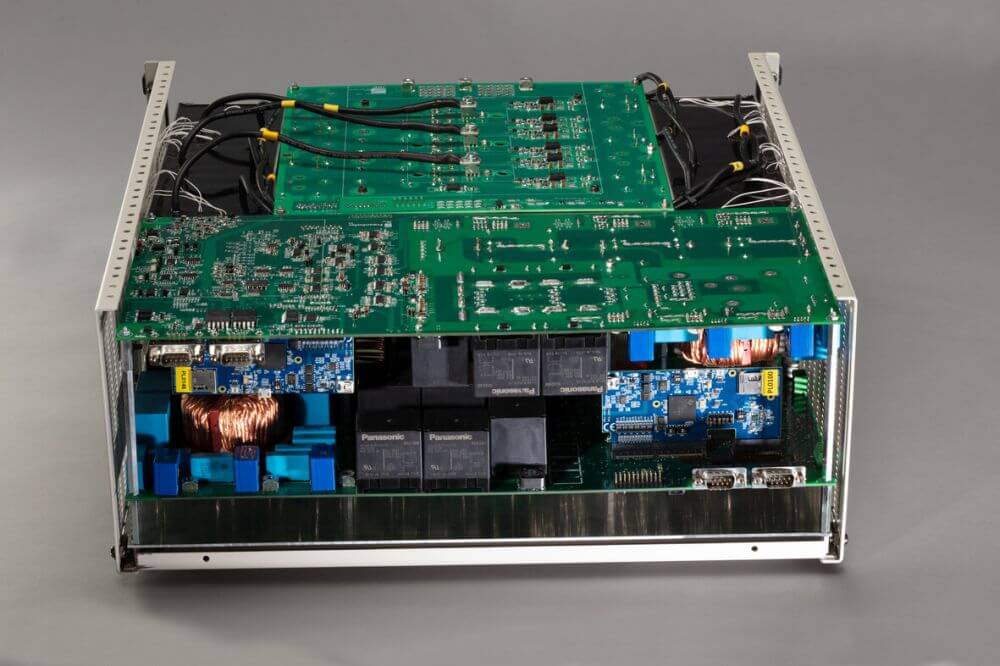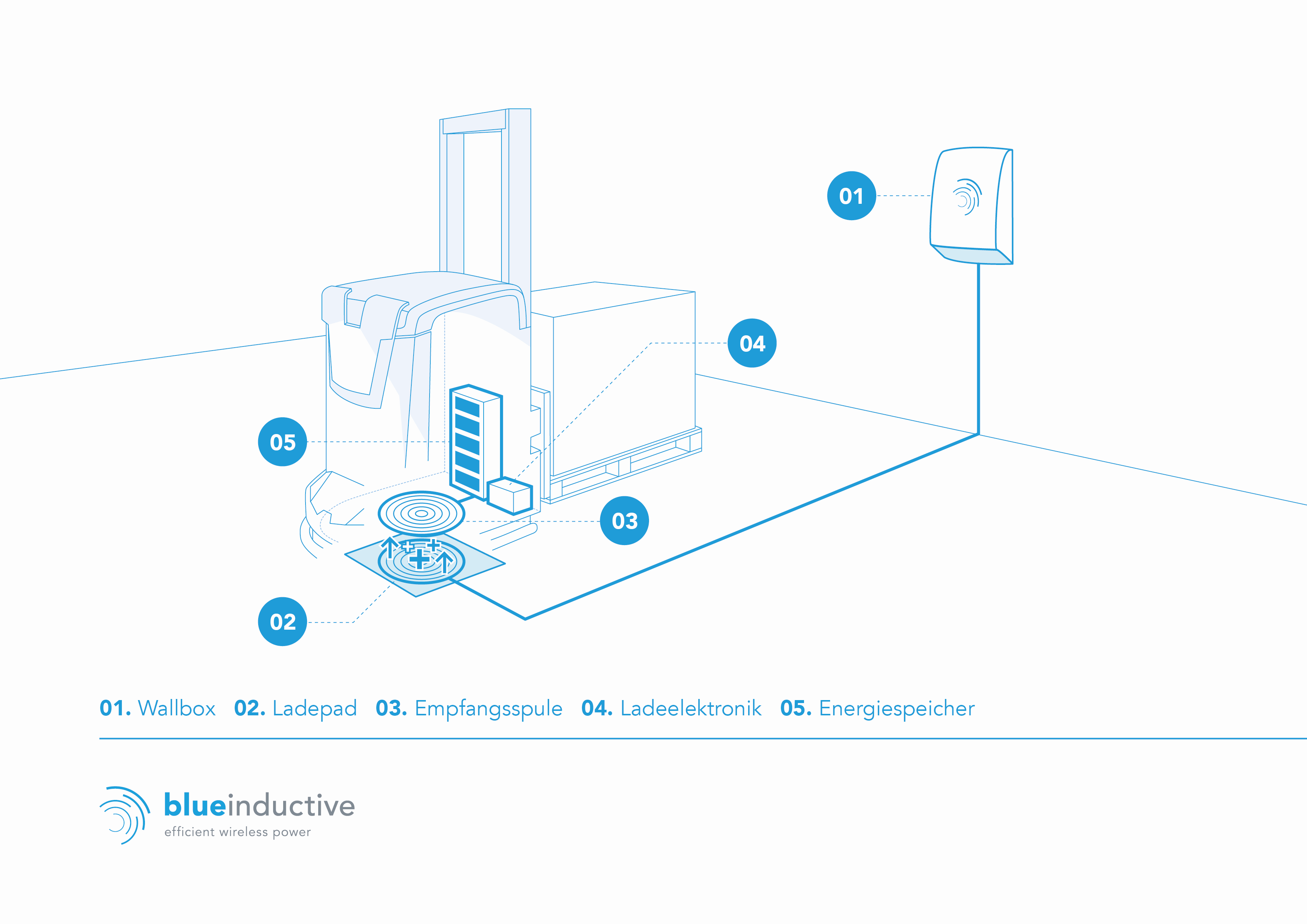| Duration: | 10/2018 - 03/2021 |
| Contracting Authority/ Sponsors: | Federal Ministry of Education and Research (BMBF), Rahmenprogramm der Bundesregierung für Forschung und Innovation 2016-2020 »Mikroelektronik aus Deutschland – Innovationstreiber der Digitalisierung« FKz: 16EMO0382 |
| Project Partners: | Wiferion GmbH (formerly Blue Inductive GmbH), Freiburg, Germany |
| Project Focus: |
HiPoInd – High Power Inductive
Automated, Wireless Fast-Charging Technology for Autonomous Mobile Robots and Industrial Trucks


The market for industrial trucks and mobile robots is growing rapidly. At the same time, the proportion of electrically powered vehicles continues to rise due to the decarbonization of the industry. However, electric industrial trucks and mobile robots being used up to present have the major disadvantage that they have very long periods of inactivity in order to recharge batteries. As a consequence, such systems are inefficient and expensive. With an inductive fast-charging system, these "downtimes" can be reduced to a minimum and the mobile systems can be used more efficiently. As part of the project "Automated, Wireless Fast-Charging Technology for Autonomous Mobile Robots and Industrial Trucks", an inductive charging system with a charging capacity of up to 40kW is being developed. First a requirements analysis is carried out followed by the simulation of the entire system. Then the stationary charging infrastructure, coil design and mobile charging infrastructure are being developed. This is followed by the system management and control engineering of the overall system, the integration and validation in the field test.
In the field of modern battery technology, the worldwide use of electrically powered industrial trucks is growing steadily, increasingly displacing vehicles with combustion engines. In particular, the cost reduction in lithium batteries driven by the automotive sector continues to drive this development. The advantages of the electric drive are an efficient, low-noise and low-emission operation with lower maintenance costs. At the same time, the change allows vehicles to be supplied with energy from renewable sources. In this way, one of the most far-reaching social challenges - the decarbonization of the economy - is also tackled. At the same time, further changes are taking place in industry. Manual industrial trucks are increasingly being replaced by fully automated, autonomous robot systems. This development is driven by rapid progress in the fields of autonomous driving, human-machine interaction and artificial intelligence.
The energy system, consisting of a battery system and a charging system, is a key technology for the large-scale success of these vehicles. An investment in the new systems particularly pays off if they are used in an uninterrupted multi-shift operation or even 24/7.
However, with today's battery and charging systems driving frequently has to be interrupted for charges of several hours. For this purpose, the vehicle often has to drive to special remote charging stations or battery change stations. This period of inactivity can last several hours. Further disadvantages of today's charging technologies are the difficult automation of chargers with plug contacts. In addition, chargers with sliding contacts only allow very limited ground clearance, require a lot of maintenance, and very precise vehicle positioning and are subject to restrictions with regard to battery voltage and charging performance. Alternative battery replacement systems are expensive, require additional battery systems and additional storage space.
As part of the project "HiPoInd-High Power Inductive", a modular inductive fast-charging system is to be developed that charges the traction batteries of these systems fully automatically with a charging capacity of up to 40kW. Due to the elimination of plug and sliding contacts, which are common today, as well as the possibility of invisible floor integration, the system will be absolutely maintenance-free, so downtimes due to defects can be reduced to a minimum. In combination with modern lithium-ion batteries, it will also be possible to reduce charge-related downtimes by up to 80% compared to systems commonly used today. With an unparalleled charging power of up to 40kW (inductive) it will be the first system on the market for industrial applications. The customer benefits from significantly increased availability and utilization of autonomous mobile robots and/or industrial trucks in production, transport and logistics. The operating principle (see figure) of the system is the following: The stationary supply unit (1) is connected to a transmitter unit (2). The transmitter unit is integrated in the floor and thus, protected against external influences. The industrial truck or the mobile robot (6) is equipped with a receiving unit (3) via which the charging process of the battery (5) starts autonomously when the receiving unit is positioned above the transmitting unit (2). Charging is either stopped when the battery is fully charged or when the vehicle moves away from its position. The vehicle is equipped with compact power electronics (4) that regulate the charging process in the vehicle.
The power electronics department of Fraunhofer ISE develops the stationary charging infrastructure for better network integration of the inductive charging system. In addition, new modulation methods for inductive energy transmission are being investigated. The simulation and dimensioning of the coil system in combination with stationary and mobile power electronics is also the subject of research.
The research project "HiPoInd" is funded by the Federal Ministry of Education and Research (BMBF) and supported by VDE/VDI/IT. In addition to the Fraunhofer Institute for Solar Energy Systems (ISE), Wiferion GmbH (formerly Blue Inductive GmbH) is the project coordinator.